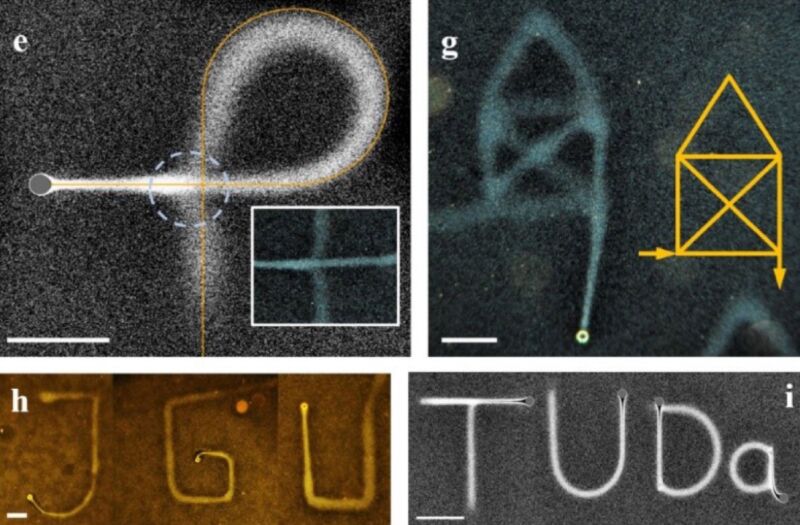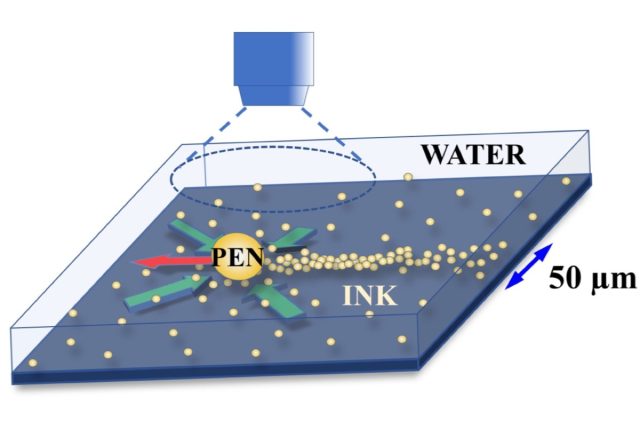
Human writing and drawing dates back at least 30,000 years and incorporates traditional techniques such as carving, engraving, and printing/writing with ink, as well as more novel methods such as electron lithography. Now a team of German physicists has figured out a unique method for writing in water and other fluid substrates, according to a recent paper published in the journal Small.
According to the authors, most classical writing methods involve the same basic approach, in which a line is carved out or ink deposited. On a solid substrate, strong intermolecular forces help the written figures hold their shape, but that's not the case for surfaces submerged in fluids. Prior research has used scanning probe lithography to "write' on self-assembled monolayers submerged in fluids, or to bring structures at the micron scale using two-photon polymerization. "There are now even commercial scuba diver slates available for underwater writing on a substrate," they wrote.
All of these methods still rely on a substrate, however. The German team wanted to devise a means of literally "writing into a fluid." Such a method would need to be robust enough to counter the rapid dispersion of drawn lines, and they would need a very tiny "pen" that didn't stir up lots of turbulence as it moved through the fluid medium. (The smaller the object moving through a fluid, the fewer vortices, or eddies, it will create.)
That kind of turbulence isn't an issue for something like skywriting at the macroscale, for instance, because the "pen" is so much smaller than the letters written in the medium (air). However, "To write fully reconfigurable lines into a liquid at the microscale, an approach fundamentally different from underwater ink deposition or line carving and a new type of micro-pen are required," the authors wrote.

The solution: put the ink directly in the water, according to co-author Thomas Palberg of Johannes Gutenberg Universitaet Mainz, and use a microbead made of ion-exchange material as a pen, measuring between 20 to 50 microns in diameter. The bead is so small relative to the reservoir of "ink" that it doesn't generate vortices at all. The bead "writes" by altering the local pH value of the water, attracting ink particles to those areas. It's possible to "write" a letter in water by tilting the water bath so the bead moves in a trajectory that traces out whatever letter or character one is trying to draw. Ink particles then accumulate along that trajectory and voila! You have written a letter in water.
"During our first attempts, we moved the water bath by hand but we have since constructed a programmable rocker," said Palberg. "In a water bath no bigger than a one Euro coin, we were able to produce a simple house-like pattern in the size of the tittle of an 'I' character in an 18 point font, and then viewed this under the microscope."
Palberg emphasizes that this work is primarily proof of principle and their research is still quite preliminary. But the team thinks their method should be able to reproduce any kind of writing that uses continuous lines. It may even be possible to have breaks between separate letters by switching the ion exchange process on and off as needed, or erasing and/or correcting what has been "written." And employing "adhesive" inks sensitive to UV light might help fix lines and letters in place for longer.
"In addition to beads made of ion exchange resins, 'pens' consisting of particles that can be heated by lasers could be employed or even individually steerable microswimmers," said co-author Benno Liebchen of TU Darmstadt. "This could even allow extensive parallel writing of structures in water. Hence, the mechanism could also be used to generate highly complex density patterns in fluids."
Small, 2023. DOI: 10.1002/smll.202303741 (About DOIs).



3175x175(CURRENT).thumb.jpg.b05acc060982b36f5891ba728e6d953c.jpg)
Recommended Comments
There are no comments to display.
Join the conversation
You can post now and register later. If you have an account, sign in now to post with your account.
Note: Your post will require moderator approval before it will be visible.